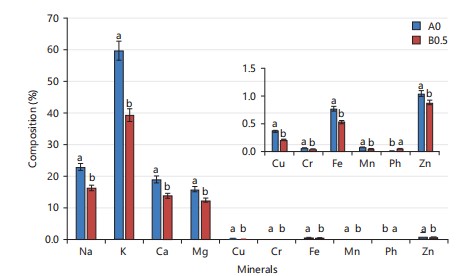Impart of Fermentation on the Nutritional and Metal Composition of Functional Beverage Blend
| Received 03 Nov, 2024 |
Accepted 09 Jan, 2025 |
Published 30 Mar, 2025 |
Background and Objective: In African countries, the percentage of people who have access to quality foods is below 30%, therefore ready to drink healthy beverages can solve the problems that come with malnutrition. This study aimed to evaluate the effect of fermentation on the nutritional profile and metal content of functional food blends developed for a health-enhancing beverage. Materials and Methods: Garlic, ginger, bitter kola, turmeric, lime, neem leaf and onion were sterilized, ground and mixed with sterile water to extract juice. Pineapple juice was added as a sweetener. The mixture was split into two batches, pasteurized and cooled. One batch was fermented with Saccharomyces cerevisiae for 5 days, while the other remained unfermented. Results: The fermented beverage exhibited a significant reduction in ash (0.14%), fat (0.85%) and carbohydrate content (0.84%) compared to the unfermented beverage, which contained 0.19, 1.93 and 0.84%, respectively. The metal content also decreased substantially in the fermented beverage. Conversely, a slight increase was observed in the crude protein content, rising from 0.42% in the unfermented beverage to 0.54% in the fermented beverage. Conclusion: Nutritional and metal analyses revealed that the unfermented juice had superior nutritional value, making it a recommended option for malnourished or immunocompromised individuals.
INTRODUCTION
For ages, it has been discovered that some plant products are beneficiary to mankind if consumed in the right proportion. Garlic, ginger, bitter kola, neem leaf, onion, moringa, citrus and some other plant produce or products have been found to have antimicrobial and antioxidant properties1.
Garlic (Allium sativum) has long been used medically and in recent times it is known for its cardiovascular antineoplastic and antimicrobial properties2. Fresh garlic contains an amino acid called allin which is considered the major biological active component of garlic. It also contains vitamin C, vitamin B6, selenium and manganese3. Ginger (Zingiber officinale) is used mostly as a flavouring agent. Aside from this, it’s also full of nutrients. A tablespoon of fresh ginger has 4.8 calories, 1.07 g of carbohydrate, 0.12 g of dietary fiber, 0.11 g of protein, 0.5 g of fat, 0.11 g of sugar, vitamins and minerals in trace amounts. Ginger has also been proven to have anti-inflammatory and anticancer effects4. Turmeric (Curcuma longa) is used widely as a spice and according to the US Food and Drug Administration, it can be used to treat any disease5. Benzie and Wachtel-Galor6 reported that turmeric can be used to treat digestive disorders, abdominal pain, skin cancer, smallpox, chicken pox and urinary tract infections. Lime (Citrus aurantifolia) is rich in vitamin C and its pulp and peel contain diverse phytochemicals including polyphenols and terpenes7. Neem leaf (Azadirachta indica) has antifungal, antidiabetic, antibacterial, contraceptive and sedative properties8. It is used in preparing vegetable soup in India, it has a strong bitter taste. Bitter cola (Garcinia kola)9 contains 70.31% carbohydrate and 11.27% protein. All these indicate that bitter kola has a high nutritional value. This research work aimed to investigate the effects of fermentation on the nutritional composition and metal values of functional foods juiced together for a healthy drink. Combining garlic, ginger, bitter kola, neem leaf, onion, moringa and citrus to make a juice that can be used to naturally boost the immune system of man to combat immunodeficiency and other related diseases, since these natural plants have been known to have beneficial effect on man with little or no known adverse effect when consumed in the right proportion. The purpose of this study was to investigate whether combining all these plants into a single beverage will enhance its nutritional benefits.
MATERIALS AND METHODS
Study area: The study was conducted from early April, to late October, 2023.
Sample collection: The samples used were purchased from a farm situated at Benin-Owena multipurpose dam and farmland, Ondo State, Nigeria. These plants produce (garlic (Allium sativum), ginger (Zingiber officinale), bitter kola (Garcinia kola), turmeric (Curcuma longa), lime (Citrus aurantifolia), neem leaf (Azadirachta indica), onion (Allium cepa) and pineapple (Ananas comosus)) were taken to laboratory, washed and kept in cool dry place for further treatments and use.
Preparation of functional food drink: The plant’s products are garlic (Allium sativum), ginger (Zingiber officinale), bitter kola (Garcinia kola), turmeric (Curcuma longa), lime (Citrus aurantifolia), neem leaf (Azadirachta indica) and onion (Allium cepa) were rinsed under running water and soaked in Huwa-san sterilizing fluid (containing 5% hydrogen peroxide) for 30 min, sliced then dried in oven at 40°C for 48 hrs10 and ground into powder11. From the powdered plant products, the following quantities were weighed separately into a stainless bowl and mixed: Ginger 50 g, turmeric 50 g, garlic 20 g, bitter kola 10 g, onion 30 g and neem leaf 30 g. Two liters of sterile water at 35°C were used to soak the combined powder for 2 hrs, after which they were mixed with a mechanical stirrer and a screw press was used to squeeze out the juice, this made extract A. To make extract B, matured pineapple, washed, peeled and weighed (2000 g) was ground in the blender with 500 mL of water and sieved with sterile muslin cloth given the total yield of 1.5 L. Extract A and B were mixed in a stainless bowl to form a juice and divided into two. A part was pasteurized at 62°C for 30 min and cooled rapidly12, the other part was not pasteurized serving as a control. The pasteurized juice was divided into 2 equal parts (2 L each), Saccharomyces cerevisiae was introduced to a part and allowed to ferment for 5 days at room temperature (fermented juice (B.05)) while the remaining part was left unfermented (A0).
Proximate analysis of the plant’s juice: The B.05 and A0 were subjected to proximate analysis to determine the nutritive value of the extracts13 and subjected to statistical analysis using the Fisher LSD method at 95% confidence.
Determination of minerals present in the plant juice: The standard procedure was followed for the preparation of the sample and the analysis of metals present in the juice (B.05 and A0)14. The absorption measurements were made using a Varian spectrum AA 10 with background correction and hollow cathode lamps. Air-acetylene flame was used for the determination of all the elements.
RESULTS
Proximate analysis of the unfermented and fermented plant juice: The ash, fat and carbohydrate of unfermented juice gave 0.19, 1.93 and 1.50% reduced significantly to 0.14, 0.85 and 0.84%, respectively in fermented juice. There was a slight increase in the crude protein of fermented juice (0.53%) when compared with unfermented plant extract (0.42%) (Table 1).

|
| Table 1: | Proximate composition of the juice | |||
| Composition (%) | A0 | B0.5 |
| Ash | 0.193±0.012A | 0.143±0.015B |
| M.C | 95.94±0.318A | 96.3±1.224A |
| CP | 0.42±0.01B | 0.537±0.015A |
| Fat | 1.933±0.076A | 0.85±0.03B |
| Fiber | - | - |
| CHO | 1.503±0.317A | 0.837±0.099B |
| Fermented juice (B.05), unfermented (A0), MC: Moisture content, CP: Percentage of crude protein and CHO: Carbohydrates | ||
Metals: The metal values in fermented juice reduced significantly when compared with the unfermented juice (Fig. 1). The highest metal value is 60% indicating that 60% of the metal content in the beverage is potassium.
DISCUSSION
Functional foods are foods that provide health benefits beyond basic nutrition. These foods contain bioactive compounds that may improve health, reduce disease risk or promote well-being15. Both fermented and unfermented beverages are rich in nutrients and minerals and can improve or support good health. This finding is in line with previous studies16,17, which reported that the combination of ginger, turmeric and garlic increased bioactive compounds that can exert pharmacological effects. According to Vishwas et al.18, a neem, ginger and garlic powder mixture was able to improve the immune responses of layer birds against Newcastle diseases.
Dietary metals serve important roles in bodily functions; even trace amounts can improve health and well-being. Zinc and copper are essential for a healthy immune system2. Metals ions that are important to our health include calcium, chromium, copper, iron, magnesium, manganese, molybdenum, potassium, sodium and zinc, contributing to the proper functioning of nerve cells, muscle cells, the brainthe heart, the transportation of oxygen and in many other biological processes. All these essential metals are present in this single drink19.
The study was limited by the lack of assessment of sensory attributes and consumer acceptability, which are critical for the marketability of the functional beverage blend. Future research should focus on scaling up the fermentation process, evaluating shelf lifeexploring the bioavailability of nutrients and metals in the beverage to enhance its functionality and consumer appeal.
CONCLUSION
This study has been able to show that plant juice obtained from garlic (Allium sativum), ginger (Zingiber officinale), bitter kola (Garcinia kola), turmeric (Curcuma longa), lime (Citrus aurantifolia), neem leaf (Azadirachta indica), onion (Allium cepa) and pineapple (Ananas comosus) mixed to make a beverage (fermented and not fermented) contains nutrients that are necessary for a healthy diet. The process of fermentation does not improve the nutritional content of the juice; therefore, need not be fermented before consumption can be used to boost the immune system of people living with immune deficiency.
SIGNIFICANCE STATEMENT
The study evaluates the effect of fermentation on the nutritional and metal content of functional foods blended into a healthy beverage. Findings indicate that while fermentation slightly increased protein content, it did not enhance overall nutritional composition. Both fermented and unfermented beverages were found to possess substantial nutrient levels, making them suitable for addressing malnutrition and aiding in the prevention of immunodeficiency diseases.
REFERENCES
- Nwokafor, C.V., C.G. Udensi, H.N. Ogbonna, C.E. Udekwu and U.D. Nwankpa et al., 2020. Antimicrobial activities of moringa, neem and ginger plant extracts against bacteria associated with the spoilage of fruit juice. S. Asian J. Res. Microbiol., 7: 21-30.
- Adebolu, T.T., O.O. Adeoye and V.O. Oyetayo, 2011. Effect of garlic (Allium sativum) on Salmonella typhi infection, gastrointestinal flora and hematological parameters of albino rats. Afr. J. Biotechnol., 10: 6804-6808.
- Shang, A., S.Y. Cao, X.Y. Xu, R.Y. Gan and G.Y. Tang et al., 2019. Bioactive compounds and biological functions of garlic (Allium sativum L.). Foods, 8.
- Mashhadi, N.S., R. Ghiasvand, G. Askari, M. Hariri, L. Darvishi and M.R. Mofid, 2013. Anti-oxidative and anti-inflammatory effects of ginger in health and physical activity: Review of current evidence. Int. J. Preventive Med., 4: S1-S7.
- Nelson, K.M., J.L. Dahlin, J. Bisson, J. Graham, G.F. Pauli and M.A. Walters, 2017. The essential medicinal chemistry of curcumin: Miniperspective. J. Med. Chem., 60: 1620-1637.
- Benzie, I.F.F. and S. Wachtel-Galor, 2011. Turmeric, the Golden Spice: From Traditional Medicine to Modern Medicine. In: Herbal Medicine: Biomolecular and Clinical Aspects, Benzie, I.F.F. and S. Wachtel-Galor (Eds.), CRC Press, Boca Raton, Florida, ISBN: 9780429130946, pp: 285-310.
- Loizzo, M.R., R. Tundis, M. Bonesi, F. Menichini, D. de Luca, C. Colica and F. Menichini, 2012. Evaluation of Citrus aurantifolia peel and leaves extracts for their chemical composition, antioxidant and anti-cholinesterase activities. J. Sci. Food Agric., 92: 2960-2967.
- Rekha, U.V., M. Anita, S. Bhuminathan and K. Sadhana, 2022. Known data on the therapeutic use of Azadiracta indica (neem) for type 2 diabetes mellitus. Bioinformation, 18: 82-87.
- Mazi, E.A., K.A. Okoronkwo and U.K. Ibe, 2013. Physico-chemical and nutritive properties of bitter kola (Garcinia kola). J. Nutr. Food Sci., 3.
- Raja, K.S., F.S. Taip, M.M.Z. Azmi and M.R.I. Shishir, 2019. Effect of pre-treatment and different drying methods on the physicochemical properties of Carica papaya L. leaf powder. J. Saudi Soc. Agric. Sci., 18: 150-156.
- Zhu, Z.Y., F. Dong, X. Liu, Q. Lv and YingYang et al., 2016. Effects of extraction methods on the yield, chemical structure and anti-tumor activity of polysaccharides from Cordyceps gunnii mycelia. Carbohydr. Polym., 140: 461-471.
- Masera, K., H. Tannous, V. Stojceska and S. Tassou, 2023. An investigation of the recent advances of the integration of solar thermal energy systems to the dairy processes. Renewable Sustainable Energy Rev., 172.
- AOACI, 2012. Official Methods of Analysis of AOAC International. 19th Edn., AOAC International, Gaithersburg, Maryland, ISBN: 9780935584837.
- Horwitz, W. and AOAC, 2000. Official Methods of Analysis of AOAC International. 17th Edn., Association of Official Analytical Chemists, Gaithersburg, Maryland.
- Temple, N.J., 2022. A rational definition for functional foods: A perspective. Front. Nutr., 9.
- Ajanaku, C.O., O.T. Ademosun, P.O. Atohengbe, S.O. Ajayi and Y.D. Obafemi et al., 2022. Functional bioactive compounds in ginger, turmeric, and garlic. Front. Nutr., 9.
- Oyinlola, K.A., G.E. Ogunleye, A.I. Balogun and O. Joseph, 2024. Comparative study: Garlic, ginger and turmeric as natural antimicrobials and bioactives. S. Afr. J. Sci., 120.
- Vishwas, K.M., T.N. Krishnamurthy, H.C. Indresh and B.N. Suresh, 2021. Effect of supplementing neem, ginger and garlic powder on immune response of commercial layers. Int. J. Curr. Microbiol. Appl. Sci., 10: 2189-2194.
- Moustakas, M., 2021. The role of metal ions in biology, biochemistry and medicine. Materials, 14.
How to Cite this paper?
APA-7 Style
Adeoye,
O., Akindeko,
R., John-Isa,
J. (2025). Impart of Fermentation on the Nutritional and Metal Composition of Functional Beverage Blend. Asian Science Bulletin, 3(1), 58-62. https://doi.org/10.3923/asb.2025.58.62
ACS Style
Adeoye,
O.; Akindeko,
R.; John-Isa,
J. Impart of Fermentation on the Nutritional and Metal Composition of Functional Beverage Blend. Asian Sci. Bul 2025, 3, 58-62. https://doi.org/10.3923/asb.2025.58.62
AMA Style
Adeoye
O, Akindeko
R, John-Isa
J. Impart of Fermentation on the Nutritional and Metal Composition of Functional Beverage Blend. Asian Science Bulletin. 2025; 3(1): 58-62. https://doi.org/10.3923/asb.2025.58.62
Chicago/Turabian Style
Adeoye, Omolara, Robinson Akindeko, and Justinah John-Isa.
2025. "Impart of Fermentation on the Nutritional and Metal Composition of Functional Beverage Blend" Asian Science Bulletin 3, no. 1: 58-62. https://doi.org/10.3923/asb.2025.58.62

This work is licensed under a Creative Commons Attribution 4.0 International License.



